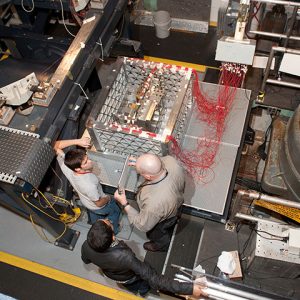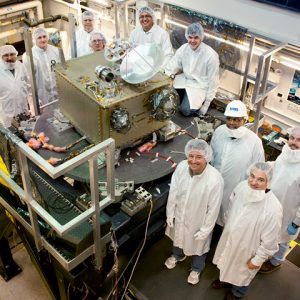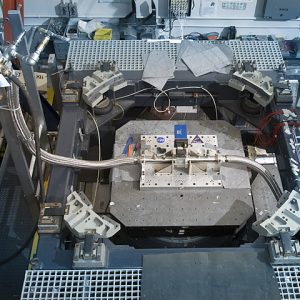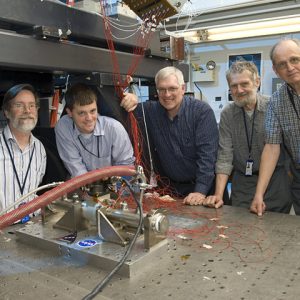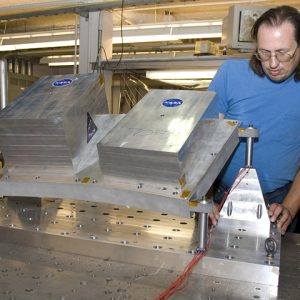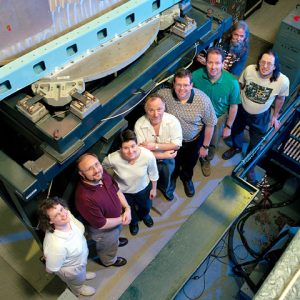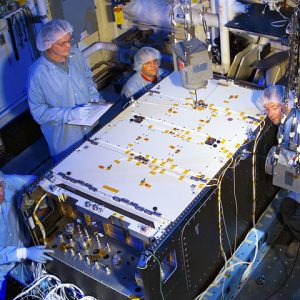Structural Dynamics Laboratory
The Structural Dynamics Laboratory (SDL) performs structural dynamic testing to verify the survivability of a component or assembly when exposed to vibration stress screening, or a controlled simulation of the actual flight or service vibration environment.
Facility Overview
The Structural Dynamics Laboratory, or SDL, performs tests to verify the survivability of a component or assembly when exposed to vibration stress screening or a controlled simulation of the actual flight or service vibration environment.
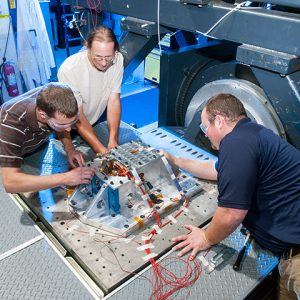
Environmental stress screening, or workmanship vibration, is used to identify latent manufacturing defects of components before they are incorporated into larger assemblies. Vibration testing is also used to verify design margins of assemblies and to characterize the internal dynamic responses of a test article.
The Microgravity Emissions Laboratory (MEL), is a part of the Structural Dynamics Laboratory which provides testing support for simulation and verification of the Space Station microgravity environment. Together, the labs combine environmental, modal, and characterization work in one facility.
Quick Facts
Structural dynamic testing is performed to verify the survivability of a component or assembly when exposed to vibration stress screening, or a controlled simulation of the actual flight or service vibration environment. Environmental stress screening, or workmanship vibration, is used to identify latent manufacturing defects of components prior to being incorporated into larger assemblies. Vibration testing is also used to verify design margins of assemblies and characterize the internal dynamic responses of a test article.
| Name | Structural Dynamics Laboratory |
|---|---|
| Environmental Testing | Sinusoidal Vibration (sweep, dwell, chirp, burst), Random Vibration, Shock |
| Structural Characterization Testing | Resonant frequency/mode shapes, Structural damping, Component interface environments |
| Facility Manager | Kenneth.J.Pederson@nasa.gov |
Capabilities
Environmental Testing
- Sinusoidal Vibration
- Sine Sweep
- Sine Burst
- Sine Chirp
- Random Vibration
- Classical Shock
- Force Limiting
Modal Testing (Impact and MIMO)
- Boundary Conditions:
- Fixed – base
- Driven – base
- Free – Free
- 10’ X 10’ Modal Floor with a 4” X 4” mounting hole pattern
- An array of modal shakers ranging from 10 lbf to 250 lbf are available
- Resonant frequency/mode shapes Structural damping
- Component interface environment
Technical Capability Summary
- Excitation
- Data Physics 5022-3:
- Sine Peak Force: 50,000 Lbf
- Random Force rms: 36,000 Lbf
- Stroke: 3.0 in. pk-pk
- Ling Electronics 4022:
- Sine Peak Force: 40,000 Lbf
- Random Force rms: 35,000 Lbf
- Stroke: 1.5 in. pk-pk
- MB Dynamics C-60
- Sine: 6,000 Lbf
- Random: 4,500 Lbf
- Stroke: 1.0 in. pk-pk
- Data Physics 5022-3:
- Control
- Vibration Research VR9500
- 28 Input Channels
- Sinusoidal vibration control and analysis software
- Random vibration control and analysis software
- Shock control and analysis software
- Vibration Research VR9500
Data Acquisition
- MTS IDEAS Test Acquisition and Analysis Software
- Portable Data Acquisition capability
Contact
Structural Dynamics Laboratory
Facility Manager: Emma Pierson
216-433-3042
emma.l.pierson@nasa.gov
Using Our Facilities
NASA’s Glenn Research Center provides ground test facilities to industry, government, and academia. If you are considering testing in one of our facilities or would like further information about a specific facility or capability, please let us know.
Did you test in one of our facilities? Let us know about your experience by participating in our customer facility evaluation survey.

